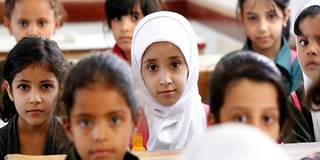In the Middle East and North Africa, girls comprise the majority of out-of-school children. Given the many social and economic benefits associated with higher school attendance for girls, the need to address the gender gap in education is obvious.
FEZ – When it comes to gender parity, the Middle East and North Africa (MENA) is lagging behind most of the rest of the world. This is undermining the prospects not just of women and girls, but of entire countries as well. And in no area is this reality more acute than in education.
In many MENA countries today, virtually everyone’s education is suffering, owing to decades of conflict, displacement, and economic malaise. In South Sudan, for example, at least 2.2 million children are not in school – one of the highest rates globally, according to a new report by the Global Initiative on Out-of-School Children. In many parts of the region – particularly rural, deprived, and overpopulated areas – even children who are in school do not receive a quality education.
But it is girls who bear the brunt of the problem, as they comprise the majority of out-of-school children. Given the many social and economic benefits associated with higher school attendance by girls – including faster GDP growth, reduced poverty, fewer child marriages, lower fertility, and better child health – the need to address the gender gap in education is obvious.

FEZ – When it comes to gender parity, the Middle East and North Africa (MENA) is lagging behind most of the rest of the world. This is undermining the prospects not just of women and girls, but of entire countries as well. And in no area is this reality more acute than in education.
In many MENA countries today, virtually everyone’s education is suffering, owing to decades of conflict, displacement, and economic malaise. In South Sudan, for example, at least 2.2 million children are not in school – one of the highest rates globally, according to a new report by the Global Initiative on Out-of-School Children. In many parts of the region – particularly rural, deprived, and overpopulated areas – even children who are in school do not receive a quality education.
But it is girls who bear the brunt of the problem, as they comprise the majority of out-of-school children. Given the many social and economic benefits associated with higher school attendance by girls – including faster GDP growth, reduced poverty, fewer child marriages, lower fertility, and better child health – the need to address the gender gap in education is obvious.